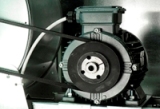Operating conditions of electric motors
 The operating conditions of a general industrial electric motor include location and climate, temperature and humidity, altitude, as well as mechanical stress and environmental dustiness.
The operating conditions of a general industrial electric motor include location and climate, temperature and humidity, altitude, as well as mechanical stress and environmental dustiness.
Performances can be found by available categories:
1 — outdoor work;
2 — work under a shed, protected from direct exposure to sunlight and precipitation;
3 — use in closed rooms without artificial temperature control;
4 — installation in closed rooms with artificially controlled climate (heating).
Engines are classified by climate:
U — moderate;
T — tropical;
UHL — moderately cold;
CL — cold.
The climate version and placement category must be indicated on the motor nameplate in its make after indicating the number of poles, for example U3, UHL1.
The table below shows the values of temperature and air humidity for climatic conditions (GOST 15150).
Climatic characteristics
Accommodation category Operating temperature min Operating temperature max Maximum value of relative humidity I have 1.2 -45 +40 100% at 25 degrees Celsius I have 3 -45 +40 98% at 25 degrees Celsius UHL 4 +1 +35 80% at 25 degrees Celsius T 2 -10 +50 100% at 35 degrees Celsius HL, UHL 1.2 -60 +40 100% at 25 degrees Celsius
Standard general industrial electric motors are manufactured with climate modification U3 or (less often) U2.
Electric motors can operate at temperatures higher than the maximum operating temperature indicated in the table. To do this, it is necessary to reduce the power so that the electric motor does not overheat, as in the table below:
Ambient temperature, degrees C 40 45 50 55 60 Output power,% 100 96 92 87 82
Electric motors are designed for use at altitudes up to 1000 meters above sea level. When working at high altitude, it is necessary to reduce the output power in accordance with the table:
Height above sea level, m 1000 1500 2000 2500 3000 2500 4000 4300 Output power,% 100 98 95 92 88 84 80 74
In accordance with GOST51689-2000, electric motors can be fixed on foundations and other supports with vibrations from external sources with an acceleration of no more than 10 m / s2, a frequency of no more than 55 Hz, while there should be no shock loads.
According to GOST 14254-80, protection against moisture and dust of an electric motor is regulated as follows: the degree of protection is indicated by the letters IP and two numbers, the first of which indicates the protection of the electric motor against the penetration of solid particles into the housing, the second — against the penetration of water.
Degrees of protection against ingress of solid bodies:
First digit after IP Degree of protection 0 No special protection 1 Protection against the penetration of solid bodies over 50 mm 2 Protection against the penetration of solid bodies over 12 mm 3, 4 Protection against the penetration of solid particles larger than 1 mm 5 The penetration of dust in the shell is not completely prevented, but cannot penetrate in an amount sufficient to affect the operation of the electric motor 6 Dust penetration is completely prevented
Degrees of protection of the electric motor against water penetration:
Second digit after IP Degree of protection 0 No special protection 1 Drop protection: vertically falling drops on the housing should not have a harmful effect 2 Drop protection when the housing is tilted at 15 degrees: vertically falling drops on the housing should not have a harmful effect impact on the product when it is tilted at any angle up to 15 degrees from the normal position 3 Rain protection: rain falling at an angle of 60 degrees from the vertical should not have a harmful effect on the engine 4 Splash resistant: the water sprayed on the casing of the motor in any direction, should not have any harmful effect 5 Protection against water jets: a jet of water in any direction falling on the shell should not have any harmful effect on the electric motor 6 Protection against water waves: water during rough seas should not enter the engine in an amount sufficient to damage 7 Protection against water immersion: water must not penetrate when the engine is immersed in water at a certain pressure and time in an amount sufficient to damage 8 Long-term immersion in water: the engine can withstand prolonged immersion in water under the conditions specified by the manufacturer
The standard degree of protection for general industrial motors, depending on the manufacturer, is IP54 or IP55.
